by Patricia Awyan Lehman
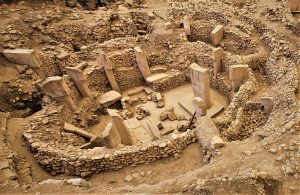
Photo by author
Göbekli Tepe, a massive site that consists of a series of mostly circular and oval-shaped structures that sit on the top of a hill, said to be 12,000 years old or more, is set in the Southeastern Anatolia Region of Turkey about 7 miles northeast of the city of Şanlıurfa.
It was very exciting for me to have finally had the opportunity to visit Turkey and especially Göbekli Tepe in mid September, 2019. Pictures do not do it justice and it was truly incredible to experience the stone circles there in person. They have been identified by most as temples and I am confident that the site once served as a university for mapping and learning about new seasons and natural cycles after the cataclysmic events that occurred around 12,500 years ago.
I had a strong feeling that the T-stones were standing there alone, long before the stone walls were constructed to surround them, as ancient stone circles marking time and space.
There is much evidence of farming surrounding these sites, as well as the celebration of seasonal feasts and many who have been involved in excavations at the site speak about ritual practices being performed there. ‘Seasonal feasts’ can refer to the celebration of harvests and planting times—or a recognition of ‘life changing’ moments manifested by solar, lunar and stellar movements. The Farmer’s Almanac (pub. in the USA) maps out the best times to plant seeds, nurture and harvest to insure optimal benefits from agricultural practices according to celestial events, and yet many of these events also affect us in our daily lives as well as our natural environment.

Photo by author
When I was in Australia almost 5 years ago, I met a woman who had been given a wealth of indigenous knowing from local tribal elders. She became an authority on tracing the ‘starlore’ of many tribes of the Original Peoples there. We went hiking around different sites near Mt Warning, an ancient volcano that sits near the first place on mainland to receive the sun’s rays each day, and one of Australia’s most sacred and spiritually significant sites. She showed me a plant at the nearby Byron Bay, whose flowers only bloom when there is a particular alignment of Venus with the Sun. This is also the same moment that they know they must avoid swimming in the bay, because the sharks become agitated and will attack. The more she showed me about the these environmental and celestial relationships, the more I could truly understand just how much knowledge has been lost. We have forgotten our connection with all things in our natural environment.
 We can see in the image above that there are 12 T-pillars surrounding 2 huge central T-pillars in Stone Circle D, considered the most ancient of the circles at Göbekli Tepe. The ancients often equated circles with cycles. Are the outer pillars representing the 12 months of the year or the ages of the precession of the equinoxes? Maybe they were mapping cycles and the cycles within cycles? What is the significance of the opening within the circle where the two middle stones are facing?
We can see in the image above that there are 12 T-pillars surrounding 2 huge central T-pillars in Stone Circle D, considered the most ancient of the circles at Göbekli Tepe. The ancients often equated circles with cycles. Are the outer pillars representing the 12 months of the year or the ages of the precession of the equinoxes? Maybe they were mapping cycles and the cycles within cycles? What is the significance of the opening within the circle where the two middle stones are facing?
I can see many interesting comparisons in the symbolism here with that of ancient Egypt, and other places in the ancient world.

Aanen, an astronomer priest, “one who knows the procession of the sky”, was the brother of the powerful Queen Tiye, wife of Amenhotep III.
In ancient Egypt, the highest priests were astrologers and astronomers who mapped out the movement of the stars to track transforming ages and stages of consciousness, and more. As above, so below. They knew there was an interaction and relationship of the movement of the stars with their everyday lives. Most significant to them were the circumpolar stars, known as the ‘never setting stars’ –and it appears to me that the builders at Göbekli Tepe were aligning their structures to similar stars and constellations as well as other celestial icons, such as Orion.

Picture taken by author at the Sanliurfa Museum
I learned about the Soul Holes at Göbekli Tepe from viewing videos featuring Andrew Collins (who has been researching and writing about the site for many years). He wrote the book: Gobekli Tepe: Genesis of the Gods: The Temple of the Watchers and the Discovery of Eden. The soul hole in Circle D sat at the opposite end of the circle from the opening in the circle. Klaus Schmidt, who led the excavations at Göbekli Tepe from 1996 to 2014, first spoke of these circular holes cut into the rocks as being seelenloch, a word from his native German language that translates to “soul hole”. He compared them to other dolmen and structures (in other parts of the world) that contained these holes believed to have been used ritually as exit points for the soul to leave it’s physical environment and enter alternative worlds while in altered states of consciousness.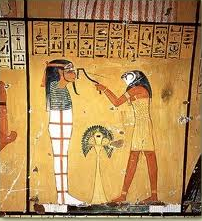 In ancient Egypt, an ‘opening of the mouth’ tool was used to symbolically reanimate the body of the deceased (and often still alive bodies). The adze shaped tool was touched to the area of the lips and eyes in what is termed “the opening of the mouth” ceremony. Some say they were opening the mouth or ‘hole’ to let wisdom and knowledge enter the lifeless physical form. The tool is shaped like the Big Dipper (Ursa Major) and is a metaphor, in my opinion, for the opening and closing of the imaginary circle/cycle of precession in our northern hemisphere–allowing for our conscious perception of life to evolve and devolve over and over again within a great eternal breath of life. This is also known as the Hero’s Journey into and out of day and night cycles (awakened states of consciousness and ages when we are ‘asleep’ or considered to be metaphorically dead) as a pattern of fractal cycles within cycles.
In ancient Egypt, an ‘opening of the mouth’ tool was used to symbolically reanimate the body of the deceased (and often still alive bodies). The adze shaped tool was touched to the area of the lips and eyes in what is termed “the opening of the mouth” ceremony. Some say they were opening the mouth or ‘hole’ to let wisdom and knowledge enter the lifeless physical form. The tool is shaped like the Big Dipper (Ursa Major) and is a metaphor, in my opinion, for the opening and closing of the imaginary circle/cycle of precession in our northern hemisphere–allowing for our conscious perception of life to evolve and devolve over and over again within a great eternal breath of life. This is also known as the Hero’s Journey into and out of day and night cycles (awakened states of consciousness and ages when we are ‘asleep’ or considered to be metaphorically dead) as a pattern of fractal cycles within cycles. The Ancient Egyptians kept close tabs on the Big Dipper, monitoring changes in the constellation’s orientation over time. They likened it to an adze or finger, the foreleg of a bull or the foreleg with a bull’s head, and sometimes as a complete bull. When you trace its anti-clockwise movement in the sky along with the pole star at the center, you see a spinning ‘swastika’. We see swastikas in symbolic designs everywhere throughout the ancient world and they are pointing out the significance of this ‘spin’ as a crucial force of nature.
The Ancient Egyptians kept close tabs on the Big Dipper, monitoring changes in the constellation’s orientation over time. They likened it to an adze or finger, the foreleg of a bull or the foreleg with a bull’s head, and sometimes as a complete bull. When you trace its anti-clockwise movement in the sky along with the pole star at the center, you see a spinning ‘swastika’. We see swastikas in symbolic designs everywhere throughout the ancient world and they are pointing out the significance of this ‘spin’ as a crucial force of nature.
The ancient Egyptian priests also used this opening of the mouth tool to symbolically open the ‘gate’ of temples (physical structures created in part to mark time and space as a symbolic mirror of the heavens and/or the human body), in order to reanimate this vibrating, spiraling energy within. Maybe they performed this ritual just before the annual floods surged up the Nile, ‘reanimating’ the temples and other structures with the additional flow of water within the subterranean channels underneath them? The high pressure of the water flowing underground causes the release of ions, which are then sent upward. These water veins can be highly energizing— and even brief exposure can have a strong effect on the physical body, as well as other organic materials such as seeds or plants.
Did the soul holes in the circles of Göbekli Tepe relate to a similar ritual practice? Were the ancients practicing rituals in both cases to metaphorically escape their own containment in form?
The ancient Egyptians looked at the eternal cycles of the Sun as a metaphor for these ages and cycles of life on Earth. However, the circumpolar stars never set below the horizon and so they viewed them as ‘eternal’ and infinite beings of light. It was their greatest hope that they could one day shine among the never-setting stars they called the Ikhemu-sek, a powerful symbol of immortality.
There are many varying translations of the Pyramid Texts from ancient Egypt. It is my opinion that they are esoteric writings that speak to an ability to move between physical and nonphysical perceptions of reality. Did the ancients have tools for traversing the spaces between heaven and earth? Were the soul holes at Göbekli Tepe, and other sites worldwide, used as an escape route for an astral journey to the heavens?
Many people today have shared stories of near death experiences, astral travels and/or visionary journeys after using plant medicines. They often speak about having a surreal experience of ‘divine connection with all that is‘. The experience is so blissful that they often don’t want to return to their 3-D physical lives again. Were the ancients able to navigate to this place in the heavens and connect with this higher power?
Ancient writings and iconography in Egypt speak of rituals that the kings would undertake, such as the Heb Sed festivals, marking a rejuvenation of their reign. After undergoing various secret rituals, (which I believe included a metaphysical journey to the stars), running with the Apis Bull, and a celebration of the unification of Upper and Lower Egypt (on one level, and a metaphor for heaven and earth or the two hemispheres of the brain on another), they would be crowned, while sitting on a throne– as the ‘Horus King’. The king had metaphorically brought the power of the heavens….down to earth. They were to be revered as a god – on earth. This has a direct relationship to a current prevalent perception that God sits on a throne.
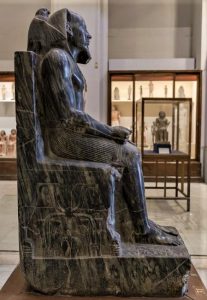
Old Kingdom ruler, Khafre in the Egyptian Museum
Many believe that Göbekli Tepe was focused on Orion and the southern horizon. Horus was known to be the ascended Osiris, his father. Orion, represented by Osiris in Egypt, is one of the most brilliant constellations in the heavens and is visible from every inhabited part of the Earth. Three bright stars decorate Orion’s belt, which points northward to the Hyades and Pleiades star clusters of Taurus, and southward to the Dog Star Sirius.
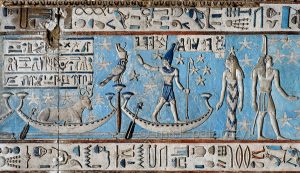
The ‘God’ Osiris (as Sah) waves good-bye to balance and stability before he descends into physical form in the Age of Cancer.
The rise and fall of Orion has been used as a cross cultural celestial metaphor for the changing seasons of our annual year. This constellation has been depicted symbolically worldwide in the form of a man with a unique belt (representing the belt stars), as a hunter or warrior. In Egypt, it is Osiris, as Orion, who embarks on the Hero’s Journey as a descent into the darkness of the material world and find his way (along the path of precession) to the light of day and ascend as he earns his wings again as the Hawk Neter, Horus (the Greek name for the Egyptian Neter, Heru) —our Hero
The ancients worldwide were fascinated by the place within the circumpolar stars where the axis, or spine of the earth is pointed towards—which often sits on a star known as the ‘pole’ star. It has been said that many ancient cultures revered the Pole Star as their God, most likely because it’s located close to the north celestial pole, the point around which the entire northern sky turns. The Armenian name for Göbekli Tepe was Portasar which is said to mean ‘Navel’, an apt name for a site that is meant to mirror this special spot in the heavens. This magical place marks the place (and state of awareness) we are at on our path of the Hero’s Journey around the circumpolar stars. Maybe the symbolism on and within the layout of the stone circles was citing something incredibly profound and significant about how we perceive reality itself?
We also visited the site of the Monastery of St. Simeon in the Province of Hatay (Antakya) in Turkey, that rises a hill that once was known as the Hill of Wonders. Simon Stylites the Younger lived on this hill, and more precisely, on a high pillar erected on its slope, in the 6th century AD. Simon sat (and meditated) on a ‘pole’ –or pillar that represented the complete balanced place of non-movement—at the polestar. This one point remains constant despite the spinning movement of the earth. It is the only bright star whose position relative to a rotating Earth does not change. All other stars appear to move opposite to the Earth’s rotation beneath them.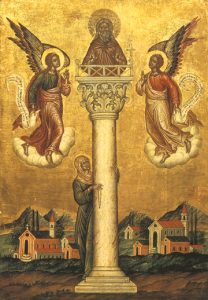 “He started the penitent life of a stylite – a person living on a pillar – at the age of twenty. He moved from one place to other several times, until he settled on a pole on top of a hill, which was later proclaimed the Hill of Wonders in his honor. Hagiographic sources relate that Simeon, while sitting on a pillar, talked with Jesus and angels. Additionally, he supposedly had the power to control the forces of nature and demons.” – Turkish Archaeological News
“He started the penitent life of a stylite – a person living on a pillar – at the age of twenty. He moved from one place to other several times, until he settled on a pole on top of a hill, which was later proclaimed the Hill of Wonders in his honor. Hagiographic sources relate that Simeon, while sitting on a pillar, talked with Jesus and angels. Additionally, he supposedly had the power to control the forces of nature and demons.” – Turkish Archaeological News
It is the axis that connects Heaven and Earth. Martin Lings equates the alif with the erect human body when he says that “the body stands for the Axis of the Universe which is none other than the Tree of Life.” (What Is Sufism, p84.)
This is the Djed Pillar of Osiris as the human spine and the dance of kundalini in the Subtle Body. The Egyptian Book of the Dead identifies this pillar as both the spine of Osiris and the axis of the universe. It represents stability. 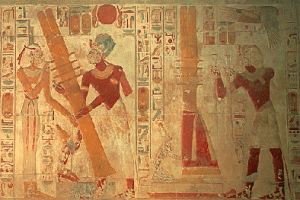
The temple priests would perform annual rituals in which they metaphorically ‘raised the Djed Pillar’ to restore stability to the land and its people. The falling and rising of this column symbolizes the falling out of and back into balance.
The Great Rift in the Milky Way, a series of dark obscuring dust clouds which stretches on through the constellation Sagittarius, was seen by cultures worldwide as the place death and rebirth, and a gateway to the higher, spiritual realms. The constellation, Cygnus, also known as the Northern Cross, marks one side of this Great Rift.
Cygnus has symbolically represented the very moment that we earn our wings and fly into the sun—through ‘the soul hole’ or pathway of souls (as described by Andrew Collins). In Egypt, Cygnus is represented by the vulture (both Nekhbet and Mut). Vultures are known to eat the ‘flesh’ of dead bodies. In fact, once the dead flesh is ingested, incredibly powerful acids in the vultures’ gut begin digesting it so completely that they even destroy the DNA. I can’t think of a better description for transforming matter into formless energy. Other symbols for Cygnus include eagles, hawks and swans- all often associated with higher states of consciousness.
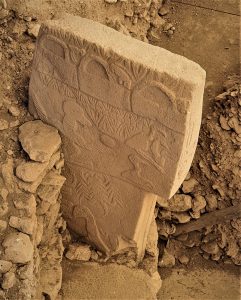
Photo by author
Many, including Andrew Collins, believe that Göbekli Tepe and its neighboring contemporary sites were referencing Cygnus and this Great Rift symbolically. However, if we accept the given timelines for the construction of this site, there would have been no distinct Pole Star. Were they alluding to a time when, Deneb, the brightest star in the constellation of Cygnus, may have held this honor from around 16,500-14,000 BC.?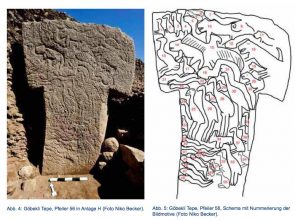
I find it fascinating that the vulture on the above Pillar 56 from Circle H at Göbekli Tepe is the only animal or bird that is facing right. All others are facing left. Does this mark a possible magnetic reversal happening at this time? Or is it noting a huge shift in consciousness? Or both?
Blogger, August Hunt points out that astronomers speak of a giant supernova explosion that occurred in the heavens within the constellation of Cygnus…which should have been visible around 8000 years ago. He postulates that this game changing event may have sparked a ‘religious revolution’:
“We know that some of the earliest grain seeds come from this area, and it was grain that made possible settled existence in the Fertile Crescent. Could it be that somehow, the great supernova in Cygnus ignited the agricultural revolution that propelled Mankind towards a higher level of development?”
This is more than possible. There are no accidents.
In my opinion, the very movement of the celestial stars around this place in the heavens, whether it is marked by a star, such as Deneb, Vega, Thuban or Polaris, or no star at all, is mapping out a journey of consciousness. This journey is played out through a dance of celestial icons that map out our transforming perceptions of reality. Just as we experience four seasons in our annual year, we also experience four seasons in the Great Year. This is also illustrated in the Vedic texts and the Vedic Cycles. When the earth is pointed toward a particular place within the spin, we are able to escape the illusion of form, and leave this ‘earthbound existence’ that is symbolically represented by the ‘containment’ within the labyrinth marked out by the movements of a celestial serpent or snake—known in ancient Egypt as Apep.
(I might add here that they are illustrating patterns of nature within their symbolism and structure to offer us the opportunity to ‘escape the illusion of form’ and wake up at any moment in time—if we can unravel this puzzle and slay the Minotaur (seed of Taurus) at the center of the ‘containment’ in this labyrinth.)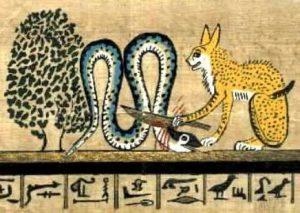
Every time me move into a ‘new age’ we suffer through catastrophic events on the planet. This is illustrated through the symbolic killing of Apep. One must destroy the old patterns before the new can be initiated. There are four major game changing moments within the Great Year. They are represented by the symbols of the lion of Leo, the bull of Taurus, the eagle or hawk of Scorpio and the human who empties the ‘containers’ of form as Aquarius. They are also symbolically represented by the Christian Gospels of Matthew, Mark, Luke and John—or the 4 horsemen of the Apocalypse.
They are represented by the symbols of the lion of Leo, the bull of Taurus, the eagle or hawk of Scorpio and the human who empties the ‘containers’ of form as Aquarius. They are also symbolically represented by the Christian Gospels of Matthew, Mark, Luke and John—or the 4 horsemen of the Apocalypse.
12,500 years ago we suffered through huge catastrophic events during the Age of Leo.
Göbekli Tepe is carbon dated c. 8800-9600 BC, which would place its construction somewhere between the astrological ages of Leo and Cancer. It has been suggested that the open ‘mouth’ of Circle D represents this time period between these ages (10,500 BC – 8000 BC) at a time when Vega was just losing its position as the pole star.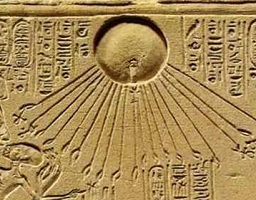
The ancient Egyptians marked this time as the Age of Aten, our highest stage of consciousness, according to indigenous knowledge holder, Abd’el Hakim Awyan. This would have been a time when they knew that our perception of reality would begin its decline into separation consciousness and we would lose our deep connection to the patterns of nature that surround us.

Many refer to the pillars numbered 31 and 18 in the center of Cricle D as the Twins of Gemini. The Age of Gemini falls between 6450 BC and. 4300 BC. Interestingly, a symbol displayed on one of these pillars is the symbol for Gemini (when displayed on its side).
This can be understood as a ladder from Earth to Heaven–or that which separates Heaven and Earth as the atmosphere of Air and Water. In sacred geometry it is the double square. Does this represent a ladder we can move up and down? The symbol underneath it can be referring to an eclipse of the sun and moon, possibly representing a moment of silence between day and night cycles.
It is during the Age of Taurus that we ‘fall completely into form’ symbolized by the Nephilim, ‘fallen angels’ or ‘angles of light’—and the once immortal demi gods (such as the followers of Horus) who either fall into a perception that they are their bodies –in physical form to walk the earth, or mate with humans to create earthbound offspring.
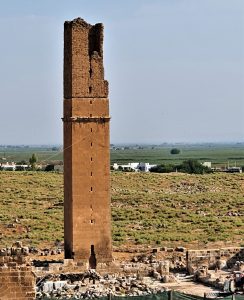
Photo by author
It is my opinion that the ancients who scribed the symbolism at Göbekli Tepe were astrologers who were mapping out both current and future cycles. I have only offered a tiny glimpse into all the possible messages they might have hidden within their symbolism. And other circles have been discovered in neighboring areas. If they did bury the sites—I believe it was to protect them from what they knew would destroy them. Did they also know that we would find them one day?
When we visited the village of Harran, south of Göbekli Tepe, we saw the Tower that was once used to trace the movement of the sun, moon and stars for astronomical and astrological purposes—at an ancient university. This is a recurring theme throughout the ancient world. We look to the stars to see our Horoscopes –or ‘scope of Horus’.
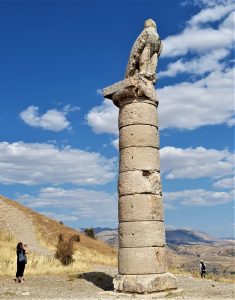
Eagle topped column at the Karakuş Tumulus in Turkey. Photo by author
Many of us have forgotten what the ancients knew; that there is a perfect time for everything (to have surgery done, to plant a seed, to travel, to meditate, to ascend to the stars, etc). When we flow with the patterns of nature we create magic—and when we oppose them, we can create our own misery. The primordial waters of the heavens is our mirror for our state of health on earth. What time is it? Where is Horus?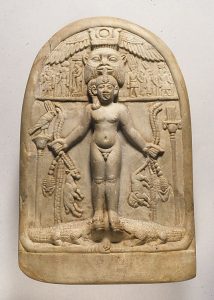 The ancient Cippus of Horus depictions show Horus standing on crocodiles (representing digestion), and holding serpents, scorpions, and other dangerous ‘beasts’ in his two hands. He is not killing the beasts—he is transmuting them. He digests his fear and anger, and transmutes his inner polarity to rise above his baser materialistic nature…to earn his wings. At the temple of Hathor at Dendera in Egypt, you find images of Horus sitting atop a lotus pillar.
The ancient Cippus of Horus depictions show Horus standing on crocodiles (representing digestion), and holding serpents, scorpions, and other dangerous ‘beasts’ in his two hands. He is not killing the beasts—he is transmuting them. He digests his fear and anger, and transmutes his inner polarity to rise above his baser materialistic nature…to earn his wings. At the temple of Hathor at Dendera in Egypt, you find images of Horus sitting atop a lotus pillar. 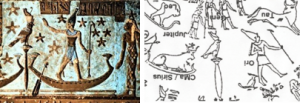 The pillar is erect, and the Hawk is wearing the double crown, symbolizing unification. Is it the unification between Upper and Lower Egypt, or a metaphor for the unification of the two hemispheres of the brain, or of the uniting of heaven and earth? If we view this as a depiction of the movements in the heavens during the precessional ‘Great Year’, he is sitting in the Age of Cancer. Did the ancients have knowledge of secrets that would enable them to traverse time and space in order to ascend to higher states of awareness within one Yogic Breath? There are cross cultural legends of ancient cultures that did.
The pillar is erect, and the Hawk is wearing the double crown, symbolizing unification. Is it the unification between Upper and Lower Egypt, or a metaphor for the unification of the two hemispheres of the brain, or of the uniting of heaven and earth? If we view this as a depiction of the movements in the heavens during the precessional ‘Great Year’, he is sitting in the Age of Cancer. Did the ancients have knowledge of secrets that would enable them to traverse time and space in order to ascend to higher states of awareness within one Yogic Breath? There are cross cultural legends of ancient cultures that did.
We all chose to be here now—on purpose. We have enrolled in the university of the navigation of the currents of life itself. If we can decipher the codes left by the ancients we might be able to cut the cord of our current cycle of chaos to begin a new breath of harmony and peace.
